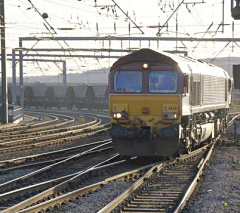 CHALLENGE: Maintaining electric trains |
Not surprisingly, the OHTE can experience all kinds of problems—impacts can bend or kink the pantograph or contact wires resulting in arcing and pitting as the pantograph bounces, and improperly tensioned contact wires can cause the pantograph to bounce. Additionally, places where contact wires overlap can be improperly graded, subjecting the pantograph to excessive vertical forces.
Spoornet, a South African transportation company, implemented a force-based conditioning monitoring system to measure the triaxial forces experienced by the pantograph and the contact wire, contact wire height above the rail, and the stagger of the contact wire, and thus avoid catastrophic failures of the OHTE. The instrumented pantograph uses specially designed load cells to measure the dynamic interaction between pantograph and OHTE; fiber-optic strain gauges from FISO Technologies are bonded to the load cells to provide the sensing element. Because the strain gauges are fiber-optic, they are immune to EMI, have high sensitivity, and are robust-all important qualities in an environment full of electrical and electromagnetic interference, mechanical vibrations, and environmental extremes. The system also includes GPS and monitoring of the control systems.
Spoornet currently has three of the overhead condition monitoring systems in use. One sits atop a 25 kV AC specially modified locomotive, another mobile system can be fitted to any class of electrical locomotive currently operating in South Africa, and the third is fitted to the company's track geometry recording car. Analyzing the data allows the maintenance planner to prioritize maintenance tasks, spotting where impacts occur, identifying locations with low-tensioned contact wires, and identifying where incorrect grading of contact wire at an overlap causes vertical impacts to the pantograph.
Contact David Johnson, Sequoia Technology Ltd., Reading, U.K.; +44 (0)118-976-9014, [email protected].